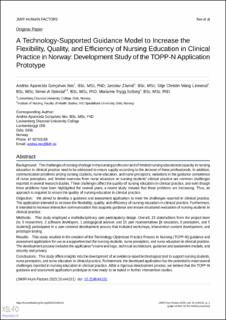| dc.contributor.author | Nes, Andrea Aparecida Gonçalves | |
| dc.contributor.author | Zlamal, Jaroslav | |
| dc.contributor.author | Linnerud, Silje | |
| dc.contributor.author | Steindal, Simen Alexander | |
| dc.contributor.author | Solberg, Marianne Trygg | |
| dc.date.accessioned | 2024-04-11T12:52:33Z | |
| dc.date.available | 2024-04-11T12:52:33Z | |
| dc.date.created | 2023-02-04T13:13:09Z | |
| dc.date.issued | 2023 | |
| dc.identifier.citation | Nes AAG, Zlamal J, Linnerud SCW, Steindal SA, Solberg MT A Technology-Supported Guidance Model to Increase the Flexibility, Quality, and Efficiency of Nursing Education in Clinical Practice in Norway: Development Study of the TOPP-N Application Prototype JMIR Hum Factors 2023;10:e44101 | en_US |
| dc.identifier.issn | 2292-9495 | |
| dc.identifier.uri | https://hdl.handle.net/11250/3126140 | |
| dc.description.abstract | Background:
The challenges of nursing shortage in the nursing profession and of limited nursing educational capacity in nursing education in clinical practice need to be addressed to ensure supply according to the demand of these professionals. In addition, communication problems among nursing students, nurse educators, and nurse preceptors; variations in the guidance competence of nurse preceptors; and limited overview from nurse educators on nursing students’ clinical practice are common challenges reported in several research studies. These challenges affect the quality of nursing education in clinical practice, and even though these problems have been highlighted for several years, a recent study showed that these problems are increasing. Thus, an approach is required to ensure the quality of nursing education in clinical practice.
Objective:
We aimed to develop a guidance and assessment application to meet the challenges reported in clinical practice. The application intended to increase the flexibility, quality, and efficiency of nursing education in clinical practice. Furthermore, it intended to increase interactive communication that supports guidance and ensure structured evaluation of nursing students in clinical practice.
Methods:
This study employed a multidisciplinary user-participatory design. Overall, 23 stakeholders from the project team (ie, 5 researchers, 2 software developers, 1 pedagogical advisor, and 15 user representatives [4 educators, 6 preceptors, and 5 students]) participated in a user-centered development process that included workshops, intervention content development, and prototype testing.
Results:
This study resulted in the creation of the Technology-Optimized Practice Process in Nursing (TOPP-N) guidance and assessment application for use as a supportive tool for nursing students, nurse preceptors, and nurse educators in clinical practice. The development process included the application’s name and logo, technical architecture, guidance and assessment module, and security and privacy.
Conclusions:
This study offers insights into the development of an evidence-based technological tool to support nursing students, nurse preceptors, and nurse educators in clinical practice. Furthermore, the developed application has the potential to meet several challenges reported in nursing education in clinical practice. After a rigorous development process, we believe that the TOPP-N guidance and assessment application prototype is now ready to be tested in further intervention studies. | en_US |
| dc.language.iso | eng | en_US |
| dc.publisher | JMIR Publications | en_US |
| dc.rights | Navngivelse 4.0 Internasjonal | * |
| dc.rights.uri | http://creativecommons.org/licenses/by/4.0/deed.no | * |
| dc.subject | communication | en_US |
| dc.subject | educator | en_US |
| dc.subject | eHealth | en_US |
| dc.subject | mobile health | en_US |
| dc.subject | application | en_US |
| dc.subject | nursing profession | en_US |
| dc.subject | nursing | en_US |
| dc.subject | technological tool | en_US |
| dc.subject | metacognition | en_US |
| dc.subject | constructive alignment | en_US |
| dc.subject | nursing students | en_US |
| dc.subject | guidance application model | en_US |
| dc.subject | clinical practice | en_US |
| dc.title | A technology-supported guidance model to increase the flexibility, quality, and efficiency of nursing education in clinical practice in Norway: Development study of the TOPP-N Application Prototype | en_US |
| dc.type | Peer reviewed | en_US |
| dc.type | Journal article | en_US |
| dc.description.version | publishedVersion | en_US |
| dc.rights.holder | ©Andréa Aparecida Gonçalves Nes, Jaroslav Zlamal, Silje Christin Wang Linnerud, Simen A Steindal, Marianne Trygg Solberg. Originally published in JMIR Human Factors (https://humanfactors.jmir.org), 03.02.2023. | en_US |
| dc.source.pagenumber | 1-18 | en_US |
| dc.source.volume | 10 | en_US |
| dc.source.journal | JMIR Human Factors | en_US |
| dc.identifier.doi | 10.2196/44101 | |
| dc.identifier.cristin | 2123016 | |
| cristin.ispublished | true | |
| cristin.fulltext | original | |
| cristin.qualitycode | 1 | |

